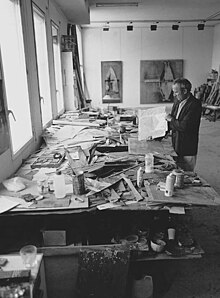Lucio Muñoz
Lucio Muñoz (born December 27, 1929 in Madrid ; † May 24, 1998 ibid) was a Spanish painter . His works on wood are remarkable. In the mid-1960s, Muñoz became increasingly interested in the everyday. His portraits and objects, his depictions of animals and dead people show the clear influence of the realistic view.
life and work
Muñoz was expelled from school and therefore worked in his father's shop. He later studied at the Real Academia de Bellas Artes de San Fernando (Royal Academy of Fine Arts of San Fernando), where he was a student of Eduardo Chicharro y Agüera . After completing his academic training, he met Madrid realists such as Antonio López, the brothers Julio and Francisco López Hernández and Amalia Avia (later his wife).
In 1956 Lucio Muñoz received a grant from the French government. There he dealt with the work of Antoni Tàpies and Jean Dubuffet . The works created by Muñoz afterwards are attributed to informalism . In 1983 he won the Spanish National Prize for Fine Arts. In 1989 the Museo Reina Sofía de Madrid dedicated an anthological exhibition to his work.
Lucio Muñoz worked with different materials such as burnt paper, wood, etc. He pierced, tore, made cuts in the canvas, like an informalist artist. His informal works are colorful, but black dominates. In the end, his style was less aggressive because he used different materials.
literature
VV.AA. The history of Spanish art . Cologne, 1997. ISBN 3-89508-700-9
Web links
| personal data | |
|---|---|
| SURNAME | Muñoz, Lucio |
| BRIEF DESCRIPTION | Spanish painter |
| DATE OF BIRTH | December 27, 1929 |
| PLACE OF BIRTH | Madrid |
| DATE OF DEATH | May 24, 1998 |
| Place of death | Madrid |
